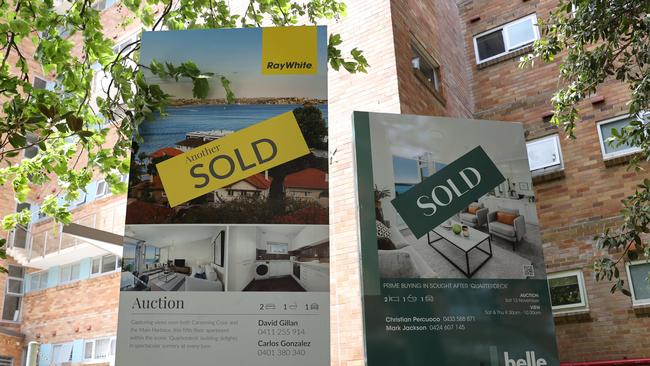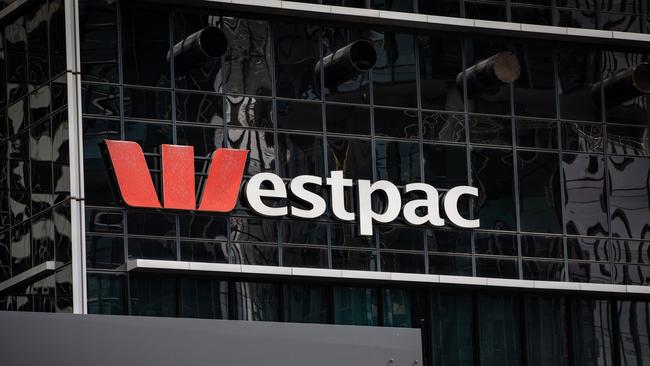Interest rates: Warning mortgage buffer spells trouble for homeowners and buyers
One of the major banks is predicting house prices are set to fall a further 8 per cent this year, yet both homeowners and buyers have been dealt a further blow.
Interest Rates
Don't miss out on the headlines from Interest Rates. Followed categories will be added to My News.
A chilling warning has been issued that some Australians could be “forced into selling their homes” after a regulator refused to budge on a key issue influencing bank’s interest rates decisions.
The Australian Prudential Regulation Authority (APRA) has refused to lower its buffer and will continue to insist that banks add 3 per cent on top of the prevailing interest rate when assessing mortgage applications.
The move not only hits the average new homebuyer, who will miss out on $21,000 in extra borrowing power according to Canstar research, but it means homeowners could also be trapped in “mortgage prison”.
The Finance Brokers Association of Australia (FBAA) said the announcement by APRA that the current serviceability buffer would be maintained makes it even harder for mortgage holders to refinance and negotiate a better rate.

FBAA managing director Peter White said the buffer – which is added to a lender’s interest rate for loan assessment purposes – means that many borrowers who can afford the interest rate of the day or even a little higher, are being unfairly prevented from refinancing.
“More borrowers are becoming mortgage prisoners locked into a situation where they can’t access a better deal because they don’t meet the inflated assessment rate,“ he said.
“Others may be forced into selling their homes because the excessive buffer rate holds them prisoner to their current lender as rates rise.
“A 3 per cent buffer was appropriate in the past because interest rates were at an all-time low and were always going to rise significantly, and this protected both the banks and the borrowers, but we can’t live in the past and a buffer of 1.5 to 2 per cent is far more appropriate today and in the near future.”

Interest rates have been predicted to peak at 4.1 per cent in the coming months before being slashed again in 2024 and 2025.
Yet, the FBAA questioned whether APRA is potentially “signalling to the market that there is another 3 per cent rise to come, because there is no other reason to keep borrowers captive”.
Mr White said it wasn’t the fault of Australian consumers that interest rates have jumped so quickly, but they are the ones being penalised.
“It’s time borrowers stopped paying the price for the rapid rise of rates,” he said.
“The FBAA was predicting the rise well before the RBA acted but at the time many didn’t believe us. Rates should have been managed better and raised in smaller increments over a longer time period.”
He called on APRA to reassess the buffer rate regularly “but not less than every two years to ensure they are fit for purpose in the market they are representing now and in the near future.”

Further analysis found existing borrowers wanting to refinance to a lower rate loan could be assessed by a lender as being unable to comfortably meet their repayments, despite currently paying a higher rate with their existing lender.
A borrower repaying a $500,000 loan over 30 years at an average variable interest rate of 5.92 per cent – who applies to refinance to a lower rate loan of 4.69 per cent would be assessed once the 3 per cent buffer is applied at a rate of 7.69 per cent.
If the lender determines they are not able to service a loan at 7.69 per cent, this implies that the borrower can’t afford repayments for a rate of 4.69 per cent even though they are currently repaying their loan at a rate that is 1.23 per cent higher, Canstar noted.
Yet the benefits of refinancing aren’t considered in the assessment as switching a $500,000 loan over 30 years from an average variable rate of 5.92 per cent to a rate of 4.69 per cent has the potential to cut repayments by $382 per month.

Canstar’s editor-at-large and money expert Effie Zahos said when rates hit rock bottom there was certainly a need for APRA to raise the buffer rate.
“The buffer acts in the interest of protecting borrowers from rate hikes. The issue is not around whether or not it is needed, it’s about the roadblock it’s causing for some existing borrowers trying to refinancing to a lower rate,” she said.
“Ironically the very regulation designed to protect consumers is working against those borrowers in mortgage prison.
“In some cases, the benefits should be taken into consideration rather than the rules. If borrowers have not defaulted on their repayments in the past 24 months, have the equity and their risk assessment remains the same, then surely refinancing to a lower rate should be possible.
“From a consumer’s point of view, it never hurts to put a case forward for refinancing or to ask about other options.”
APRA chairman John Lonsdale said current buffers “remained appropriate given the potential for domestic and global economic conditions to deteriorate” in an information paper published on Monday.

It comes as homeowners could take an even bigger hit with Westpac senior economic Matthew Hassan warning that house prices are expected to come under “intense pressure” and plummet a further 8 per cent nationally in 2023 – creating further pain for those looking to refinance.
He added prices across the five major capital cities are now down 9.7 per cent from their peak in April 2022.
“The February month has seen some moderation in price declines but this is unlikely to hold given the prospect of further rates rises,” he said.
“Recent state level tax changes also appear to have given a lift in NSW. Other indicators remain broadly negative: buyer sentiment near cycle lows, price expectations subdued, risk aversion elevated and labour market confidence softening.
“All states are now seeing corrections but conditions continue to vary significantly. Falls are more advanced and deeper in NSW, Vic and Tas. QLD has seen a sharp snap – back since mid – 2022 and both WA and SA continue to record much milder declines – markets in all three of these states still looking relatively tight in terms of both listings versus sales, and rental vacancy rates.”
Originally published as Interest rates: Warning mortgage buffer spells trouble for homeowners and buyers





